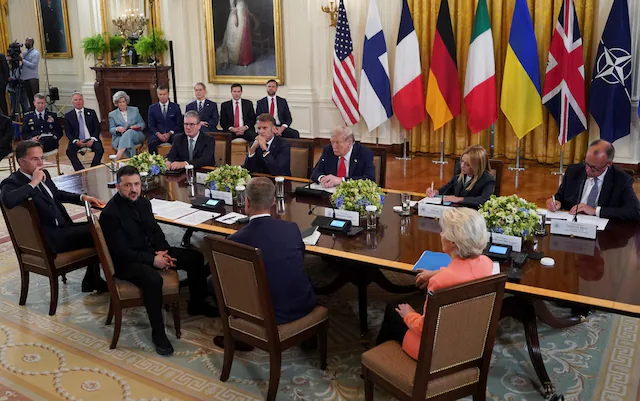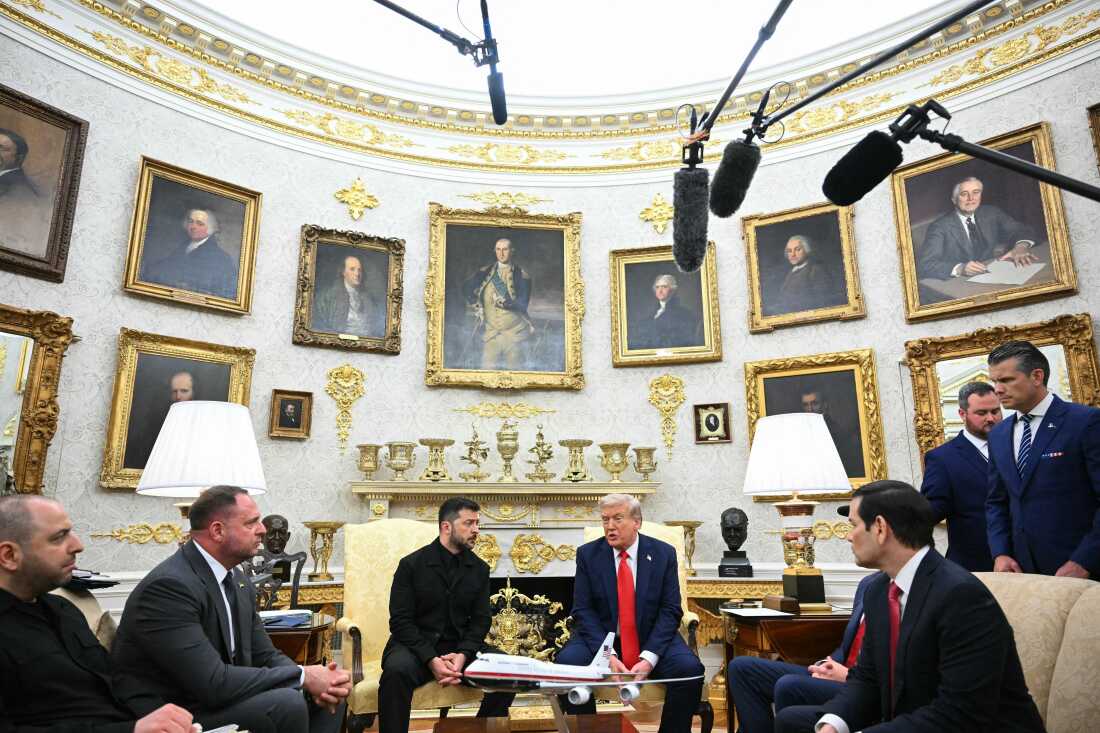A Rare Gathering in the East Room
Washington, D.C., August 18, 2025 – The East Room of the White House witnessed a rare spectacle: U.S. President Donald Trump, Ukrainian President Volodymyr Zelenskyy, and an array of European leaders gathered around the same table to chart a path toward ending the war in Ukraine.
Flanked by NATO Secretary General Mark Rutte, UK Prime Minister Sir Keir Starmer, French President Emmanuel Macron, Italian Prime Minister Giorgia Meloni, German Chancellor Friedrich Merz, Finnish President Alexander Stubb, and European Commission President Ursula von der Leyen, the event underscored an unusual moment of Western unity.
The theme was clear: security guarantees, humanitarian priorities, and the possibility of a trilateral peace summit with Russian President Vladimir Putin.
Trump: "We Want to Stop the Killing"
Opening the session, Trump emphasized the historic nature of the gathering.
“We want to stop the killing, get this settled,” Trump said. “Not since the Second World War has there been anything like this.”
The U.S. president revealed he had spoken indirectly with Putin and promised to call him immediately after the meeting. He hinted at convening a trilateral meeting with Zelenskyy and Putin, which he described as potentially “great” and “decisive.”
While acknowledging ongoing Russian aggression, Trump insisted that peace was within reach:
“I believe peace at the end of all this is attainable – and in the near future.”
Zelenskyy: Security, Prisoner Swaps, and Stolen Children
Zelenskyy, visibly buoyed by the day’s discussions, declared the meeting one of the most productive yet.
“We had a very good conversation with President Trump – maybe the best one,” he said.
The Ukrainian leader highlighted three critical priorities:
- Security guarantees – Ukraine needs firm, NATO-like commitments to safeguard its sovereignty.
- Humanitarian measures – immediate exchange of prisoners and repatriation of abducted Ukrainian children taken into Russia. Zelenskyy personally thanked First Lady Melania Trump for her letter urging action on this issue.
- No territorial concessions – any discussion of sensitive issues like borders must happen directly at leader-level trilateral talks.
Zelenskyy also presented Trump with battlefield maps, underscoring the realities of the war. “This is about unity,” he said, thanking the assembled European leaders for standing alongside Ukraine.
European Leaders Speak with One Voice
The event then turned into a rare roundtable of European power brokers, each delivering remarks that revealed both optimism and caution.
Mark Rutte (NATO)
The NATO Secretary General praised Trump’s outreach to Putin:
“You broke the deadlock by starting that dialogue. If we play this well, we can end this.”
He also confirmed NATO members had agreed to raise defense spending to 5% of GDP a dramatic shift.
Ursula von der Leyen (EU Commission)
Von der Leyen tied the talks to broader transatlantic cooperation:
“We are here as friends and allies… Our common interest is to stop the killing.”
She stressed that every abducted Ukrainian child must return home, calling it a moral and humanitarian priority.
Friedrich Merz (Germany)
Merz pressed for an immediate ceasefire:
“I can’t imagine the next meeting would take place without one.”
His comments highlighted European unease with Trump’s stance that ceasefires aren’t always necessary before negotiations.
Giorgia Meloni (Italy)
Meloni called it a “new phase” and reminded the room that Italy had originally proposed the Article 5-style guarantee model for Ukraine. She framed peace as inseparable from justice and unity.
Emmanuel Macron (France)
Macron emphasized the need for a trilateral summit with Putin, adding:
“We may even need a quadrilateral meeting, because this is about the entire security of the European continent.”
Keir Starmer (UK)
Starmer connected the war’s impact directly to European families:
“There’s not a family or community that hasn’t been affected.”
He backed a trilateral meeting as the “sensible next step” and praised the potential for a historic breakthrough on security guarantees.
Alexander Stubb (Finland)
The Finnish president, representing a country with an 800-mile border with Russia, brought historical perspective:
“In the past two weeks we’ve had more progress than in the past three and a half years.”
He pointed to Finland’s 1944 peace with Russia as a model for achieving a just and lasting solution.
The Points of Consensus
Despite differences, the East Room discussion produced several common threads:
- Security Guarantees: All agreed Ukraine’s future must be secured under NATO-like guarantees, though details remain unresolved.
- Humanitarian Urgency: Prisoner exchanges and the return of abducted children were given priority.
- Unity: European leaders and the U.S. showed unusual solidarity, rejecting the idea of territorial concessions as the price for peace.
- Trilateral Summit: Momentum built toward a Trump–Zelenskyy–Putin meeting in the coming weeks.
Trump’s Closing Notes
Trump ended the session with a mixture of confidence and caution:
“I believe you have two willing parties… and usually that’s good news. But it might not be able to be done. Still, it will save thousands of lives a week if we succeed.”
He promised to call Putin immediately after the meeting and hinted that within “one or two weeks,” the world would know if peace was truly possible.
What Happens Next?
- Call with Putin: Trump pledged to phone the Russian president directly after the East Room meeting.
- Trilateral Meeting: Planning is underway for a summit involving Trump, Zelenskyy, and Putin.
- European Follow-Up: EU leaders will return to their capitals with fresh momentum for coordinated security guarantees.
- Ceasefire Debate: Whether peace can advance without a formal ceasefire remains the central fault line.
A Historic First
For the White House, the gathering itself was historic. As Trump pointed out:
“This is the first time so many European leaders, prime ministers, and presidents have sat together here in the East Room to decide the fate of a war.”
Whether this moment becomes a turning point or just another pause in a brutal conflict will depend on what emerges from Trump’s expected call with Putin and the promised trilateral summit.
But for one afternoon in Washington, the East Room became the stage where the possibility of peace, however fragile, was laid out in unprecedented unity.
Source : RSBN



